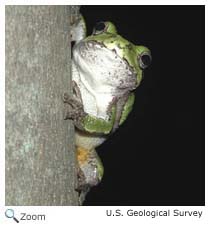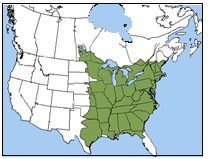Cope's Gray Treefrog - Hyla chrysoscelis |
|||||||||
Description
Range |
HabitatCope's gray treefrog lives in woodlands, grasslands, prairies, meadows, fields, and swamps. It is rarely seen on the ground. It is usually found perched on a tree or shrub. DietCope's gray treefrog finds its food in the trees and shrubs. It eats moths, tree crickets, ants, flies, grasshoppers, and beetles. Life CycleBreeding season runs from April to July. Males gather in vegetation in and near breeding ponds and call out to the females. When the male attracts a female, he comes down from his perch to mate. The female lays as many as 2,000 eggs in groups of 10-40 eggs. The eggs are attached to vegetation in the water. The tadpoles hatch in four or five days and change into froglets in about two months. Behavior
Cope's gray treefrog is nocturnal. It spends the day resting in trees and shrubs. At night it crawls among the branches and leaves looking for food. It usually only comes out of the trees and bushes during the breeding season and in the winter. It hibernates under leaves, bark, or rocks on the forest floor. |
||||||||
| Audio Credit: USGS Upper Midwest Environmental Sciences Center | |||||||||


 Cope's gray treefrog is found from Manitoba east to Maine and south to northern Florida and central Texas.
Cope's gray treefrog is found in New Hampshire.
Cope's gray treefrog is found from Manitoba east to Maine and south to northern Florida and central Texas.
Cope's gray treefrog is found in New Hampshire.